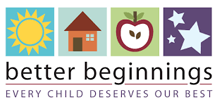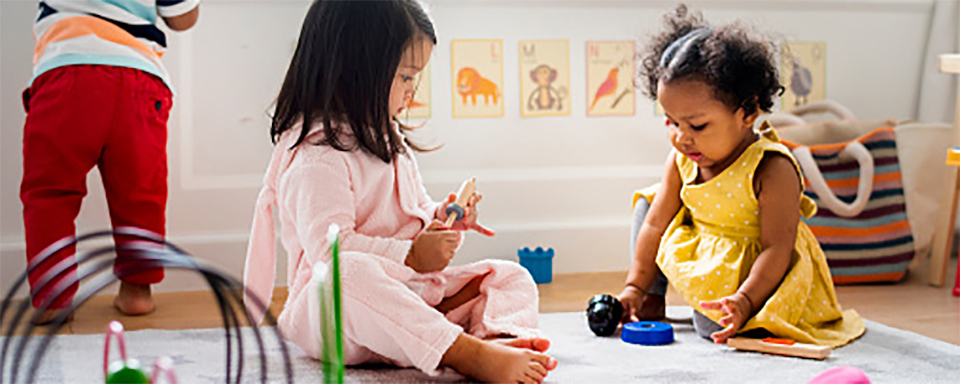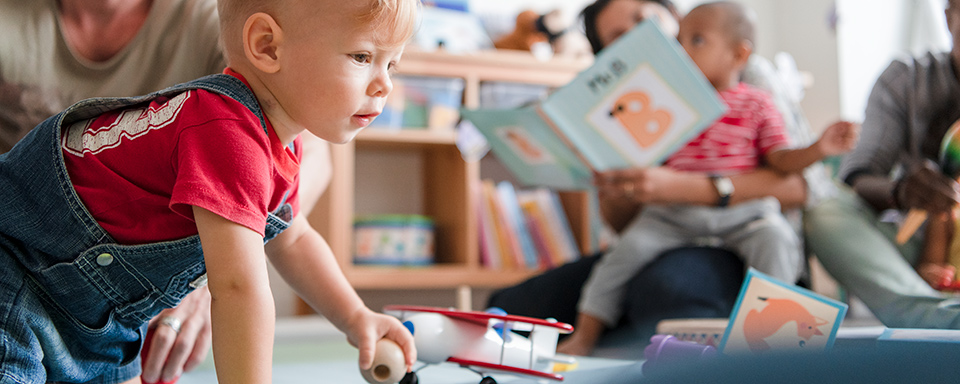Enjoy the sounds of language with your child.
Focus on Kindergarten Readiness Indicators
- Participates in singing songs and saying rhymes
- Decides if two words rhyme, for example, cat and bat
- Produces the correct sounds for some of the letters of the alphabet
- Tells increasingly detailed stories or ideas
- Names a variety of foods or begins to classify food items as either fruits or vegetables and healthy or unhealthy
- Expresses health needs such as, “I’m hungry,” “My head hurts,” or “I’m tired
Activities by week
WEEK 1
Collect materials that focus on rhyming and beginning sounds.
- Locate books of Mother Goose rhymes and poetry for young children. See the list of suggested books for this month for examples.
- Collect objects or pictures of things that rhyme. Some examples are cat and hat, rock and sock, soap and rope, and spoon and moon.
- Ask them to find any that rhyme.
WEEK 2
Read rhymes with your child.
- Read Mother Goose rhymes with your child. Encourage your child to complete the verse with the correct rhyming word, such as “Hickory, Dickory, Dock; The mouse ran up the (clock).”
- Invite your child to say with you their favorite rhymes over and over again. Your child will soon be able to say the rhymes alone.
- Read simple poems with your child. Encourage your child to complete the poem with the correct rhyming word.
WEEK 3
Play with rhyming sounds.
- While doing things around the house, such as cleaning or cooking, encourage your child to describe the activities by using words that rhyme.
- Use objects around the house, such as a sock, ball, and hat. Encourage your child to say a word that rhymes with the chosen object. Accept nonsense words that rhyme as well.
WEEK 4
Help your child match letters to objects or pictures.
- Give your child alphabet letter magnets.
- Use pictures from previous activities.
- Have your child say the name of the object to hear the beginning sound of the word.
- Ask your child to find the alphabet letter that matches the beginning sound of the word.
Additional Ideas
As your child learns to classify objects, you can work on categories with your child during mealtimes or at the grocery store, such as vegetables or fruits. Discuss the health benefits of the food.
Meals are important language development moments of the day. As you sit together at the table, talking about your day or the foods you eat helps children learn social concepts and language.
Encourage discussions about how different foods impact your child’s body. For example, does your body feel strong when you eat vegetables? Follow this idea throughout the day, having your child check in on how their body feels. Are they tired? Full of energy?
Special Activity
Make a book of rhymes that your child enjoys. Print some of your child’s favorite rhymes on unlined paper. Provide crayons or markers for your child to draw a picture to illustrate the rhyme.
Suggested Books to Read with Your Child
Barnyard Banter by Denise Fleming
Jamberry by Bruce Degen
My Very First Mother Goose by Iona Opie, Rosemary Wells, illustrator
The Napping House by Audrey Wood, Don Wood, illustrator
Read-Aloud Rhymes for the Very Young by Jack Prelutsky, Arnold Lobel, illustrator
The Random House Book of Mother Goose by Arnold Lobel
Silly Sally by Audrey Wood
There Was an Old Lady Who Swallowed a Fly by Simms Taback
Tomie dePaola’s Mother Goose by Tomie dePaola
The Wheels on the Bus by Maryanne Kovalski







